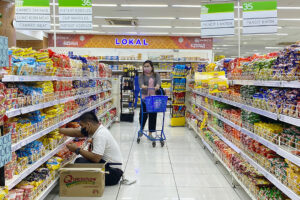




Philippines Trade Update: Trade trajectories trend along
 DOWNLOAD
DOWNLOAD

Policy Rate Updates: Double cut finale
 DOWNLOAD
DOWNLOAD

Monthly Economic Update: One for the road
 DOWNLOAD
DOWNLOAD


Consumption likely to slow amid looming recession, say experts

THE GOVERNMENT should diversify its major growth drivers to rely less on consumption as household spending is seen to slow amid a potential global recession, analysts said.
“While it is true that much of the growth is coming from consumption, this is hardly stable and is coming mainly from the easing down of the lockdowns,” Ateneo de Manila University Economics Professor Leonardo A. Lanzona said in an e-mail.
The Philippine economy grew by 7.6% in 2022, the fastest economic growth since 1976. Preliminary data from the statistics authority showed household consumption surged by 8.3% last year from 4.2% in 2021.
On the demand side, household consumption was the biggest contributor to gross domestic product (GDP) growth last year. Restaurant and hotel spending contributed the most to household expenditures amid the reopening of the economy.
HSBC Philippines Chief Executive Sandeep Uppal said during the Philippine Economic Briefing in London last week that the Philippines is seen as a destination for investments due to its “rising consumption.”
However, consumption may likely wane amid the looming global recession, University of Asia and the Pacific Senior Economist Cid L. Terosa said.
“Consumption spending heavily depends on disposable income, which could be negatively affected by a global recession. Although a major portion of the consumption spending of Filipinos is for necessities such as food, the potential impact of supply disruptions due to the global recession can exert upward pressure on prices and eventually curb consumption spending,” he said in an e-mail.
“The spending spree that we see in markets today will eventually ‘normalize’ and seek its usual level.”
The World Bank expects global growth to decelerate this year due to the fading of pent-up demand, elevated inflation, and prolonged impact of the Russia-Ukraine crisis. The multilateral lender trimmed its Philippine GDP growth projection to 5.7% for 2023-2025, from 5.8% previously.
Economic managers expect Philippine GDP to expand by 6-7% this year, narrower than its earlier target of 6.5-8% amid the anticipated global recession.
Rizal Commercial Banking Corp. Chief Economist Michael L. Ricafort said there is a need to further “diversify the country’s major sources of economic growth to increase the share of investments, both local and foreign.”
“Besides, the country’s demographics are attractive to foreign investors, at least as a large market for their products and as a source of organic growth since the country’s population is at least 110 million, the 12th largest in the world and among the youngest in the region,” he added.
Gross capital formation, the investment component of the economy, grew by 16.8% in 2022, slower than 20.3% in 2021.
Mr. Lanzona said trade-based, long-term investments are more preferable.
“Other countries in the Association of Southeast Asian Nations are mostly trade based. Because the global chain is disrupted, their growth rates are lower compared to the Philippines which is not too dependent on trade. I can predict that once the global recession ends and the global chain strengthens, these investments will leave the country,” he added.
Mr. Terosa said the Philippines should focus on attracting infrastructure investment.
“Investors do not only respond to market size and market consumption capacity. The infrastructure and institutional support for markets are important as well. Hence, the country should strive to upscale its infrastructure and to sharpen its governance-related image,” he said.
“The country should show investors that we have a trustworthy and reliable capacity to manage our economic and social resources for economic growth and economic development,” he added.
The National Economic and Development Authority (NEDA) last week said it is working on around 3,600 potential infrastructure projects worth a total of USD 372 billion. The projects will be implemented through 2028. – By Luisa Maria Jacinta C. Jocson, Reporter
This article originally appeared on bworldonline.com





 By BusinessWorld
By BusinessWorld